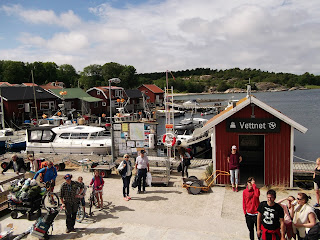"Why, do you want to go to Norway?"
It was only on hearing this that I realised exactly where I was. I'd spent the last week working as a science writer at the Society for Experimental Biology's 2017 Annual Meeting in Gothenburg (see previous posts) and was determined not to leave Sweden without seeing a bit of the countryside. Lonely planet and TripAdvisor had recommended the Kosterhavets National Park, and so, after a two hour train ride, here I was in the harbour town of Strömstad...travel weary and a little disoriented. Thankfully, the locals were friendly and spoke good enough English to direct me to the Tourist Information and the ferry terminal. Baggage stowed away in the lockers, I jumped aboard and was soon speeding across the waters to the distant islands.
 |
| The ferry terminal at Vetternet, North Koster |
The Kosterhavets is a collection of islands off the West Coast of Sweden and the country's first Marine National Park. Because the Koster Trench - a 247m deep channel that runs through the park from north to south - brings in cold, highly saline water from the North Atlantic, an abundance of rare, deep-loving marine species are able to live here despite being so close to the coast. Many of the smaller islands are also home to colonies of seals and seabirds. As the ferries were quite infrequent, I only had time for a short walk today and disembarked at Killesand on South Koster to walk to Ekenäs. But this was enough to give me a true flavour of the Kosters and the surprising variety of landscape that these tiny islands offer. Killesand itself is a beautiful, sweeping sandy beach but soon I was wandering through lush forests that put me in mind of tropical rainforests. Next I was skirting round rocky outcrops on the shore, peering through water clear as glass at the kelp forests below. At the Visitor Centre at Ekenäs, I gazed spellbound at the incredible photographs which showcased the diversity of marine life found here.
 |
| The 'Naturum' Visitor Centre at Ekenas |
I was up early the next day to catch the 8.30 am ferry as I wanted to spend as much time as possible on the islands. Firs, to North Koster, the 'wilder' of the two islands, where the sheer abundance of wildflowers was breath-taking. There was every colour and shade you could think of but I was particularly taken with Sea Holly, a low-growing, spiky bush-like plant with vicious spines on the leaves. Despite these defences, this plant is in decline and given special protection on the Kosterhavets. I followed the trail to the northern tip that my AirBnB hostess had recommended: she seemed to take it for granted that I would want to go for a swim. I decided that 'when in Sweden, do as the Swedes do'....and despite the freezing temperature, it was a great experience!
 |
| Sea Holly - a well-defended but declining plant |
 |
| A botanical paradise... |
After circuiting the island, I caught the ferry over to Långegärde on South Koster. This is the more populous of the two islands and by now was busy with people hiring bicycles to explore. I followed the main route to visit the organic garden and sculpture park, which perfectly captured the relaxed nature of Swedish culture. Surrounded by vegetable plots and greenhouses, families dined together on the freshest produce, whilst dragonflies skimmed over the pond and a flock of very cuddly sheep milled around. I had a quick tour of the sculptures but most of it went over my head and I'm not sure an English translation would have helped!
 |
| Curious encounters in the scultpture garden, South Koster |
Leaving the garden, I climbed up to the viewpoint at Valfjäll to enjoy the sweeping panorama over the islands, and the mountainous mass of Norway in the distance. Then I left the crowds and plunged back down through the forest on winding trails that eventually led me to the beach at Brevik. I stopped here to enjoy my picnic but wasn't tempted to swim, having spotted several jellyfish in the water! The afternoon was a pleasant amble round the southern headland, arriving back where I had started at Killesand.
 |
| Such clear water! |
And so I have to thank the SEB for bringing me to Sweden, a place I may never have visited otherwise. If you want clean air, natural scenery, terrific food, glorious water and a welcoming culture that embraces the outdoors, I certainly recommend it. My only regret is that I didn't get the chance to do a kayak tour of the seal colonies....next time perhaps?
Let me know if you want to join me!


No comments:
Post a Comment
Note: only a member of this blog may post a comment.